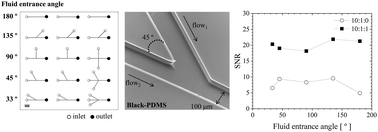Dark matters: black-PDMS nanocomposite for opaque microfluidic systems
Abstract
Optically detectable labels and probes are commonly used in bioapplications. Together with the miniaturization of analytical platforms based on microfluidic technology, with tuneable properties, they yield unparalleled opportunities towards faster, cheaper and more efficient biomolecule analysis. This work describes the preparation and testing of uniformly shaded polydimethylsiloxane (PDMS) membranes and microfluidic devices used to enhance or inhibit optical detection of fluorescent labels. The uniformly pigmented black-PDMS nanocomposite mixtures have been prepared by adding a known quantity of black pigment to PDMS, and its optical, spectroscopic and morphological properties have been characterized. The effect of pigment-to-DMS mixing ratio has been investigated by Ultra-Violet/Visible, near infrared and middle infrared spectroscopies; scanning electron microscopy and atomic force microscopy; and contact angle measurements. The results demonstrate that optical and spectroscopic properties of black-PDMS are strongly altered with the progressive inclusion of black pigment while wetting behaviour and morphology are maintained. Surface contact angle decreases more prominently with the decreasing ratio of DMS-to-curing agent than for the inclusion of pigment nanocomposite in the mixture. The ability to tune optical properties of PDMS has been experimentally demonstrated in a Black-PDMS nanocomposite microfluidic chip cast and bonded to glass. The results show double the signal-to-noise in fluorescence images as compared to pure PDMS devices, demonstrating a very promising integrated optical detection strategy for portable microfluidic systems.



 Please wait while we load your content...
Please wait while we load your content...